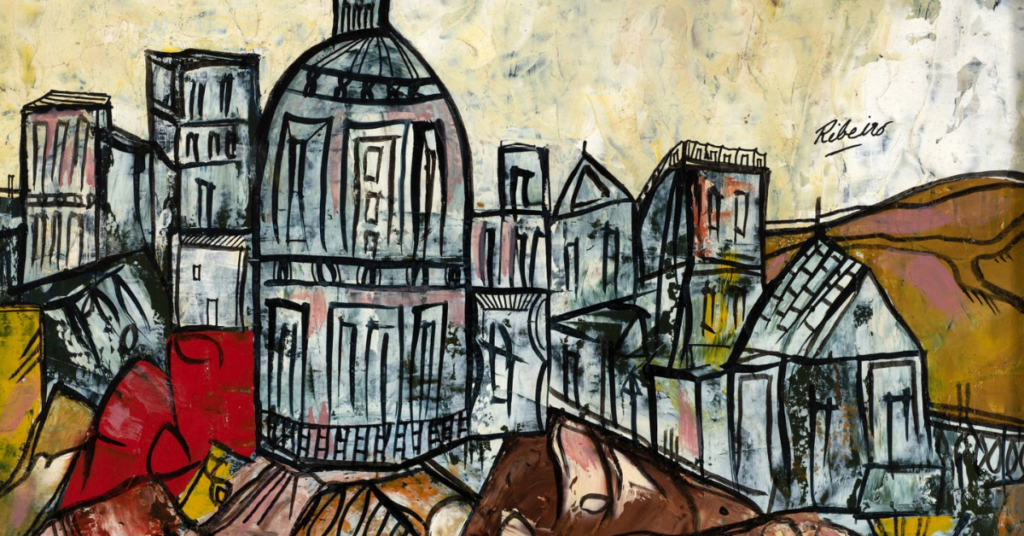Lancelot Ribeiro stands as a significant figure in the realm of modern art, celebrated for his dynamic expressionist paintings and groundbreaking experiments with materials that paved the way for contemporary acrylics. His journey from Bombay to London encapsulates a narrative of cultural fusion, artistic innovation, and a relentless pursuit of creative freedom.
Early Life and Background
Born on November 28, 1933, in Bombay (now Mumbai), India, Lanceloté José Belarmino Ribeiro hailed from a Goan Catholic family. His father, João José Fernando Flores Ribeiro, was a chartered accountant, and his mother, Lília Maria Cecília Ribeiro (née Antunes), was a milliner and tailor. Ribeiro was the half-brother of the renowned artist F. N. Souza, a relationship that would later influence his artistic trajectory.
Read: Natalie Reynolds: A Multifaceted Personality in the Digital Age
In 1950, at the age of 17, Ribeiro moved to London to pursue studies in accountancy, initially residing with his half-brother Souza. However, his passion for the arts soon overshadowed his academic pursuits. He enrolled in life drawing classes at St. Martin’s School of Art, marking the beginning of his formal artistic education.
Artistic Beginnings in India
After completing his studies and a stint in the Royal Air Force, Ribeiro returned to India in 1955. It was during this period that he began to delve deeply into painting. His early works, dating from 1958, were primarily expressionistic oil townscapes, heavily influenced by the Goan landscape and the artistic endeavors of his half-brother, Souza. These paintings often depicted archetypal heads, including representations of Christ, monks, bishops, and saints, reflecting both his cultural heritage and personal introspections.
Ribeiro’s inaugural solo exhibition took place at the Bombay Artist Aid Centre in 1961. The exhibition was a resounding success, leading to significant commissions, including a mural for Tata Iron and Steel. This period solidified his reputation as a promising artist within the Indian art community.
Transition to London and Evolution of Style
In 1962, Ribeiro made the pivotal decision to relocate permanently to London. Initially, he lived with his half-brother, F. N. Souza, and served as his studio assistant. This close association provided Ribeiro with invaluable insights into the European art scene and further fueled his desire to carve out his own niche.
During the 1960s, Ribeiro grew increasingly dissatisfied with the limitations of traditional oil paints, particularly their slow drying times and limited color vibrancy. This led him to experiment with new synthetic materials, notably polyvinyl acetate (PVA). Collaborating with major manufacturing companies such as ICI, Courtaulds, and Geigy, Ribeiro explored the potential of these materials, effectively becoming a pioneer in the use of what would later be recognized as modern acrylic paints.
Artistic Themes and Motifs
Ribeiro’s oeuvre is characterized by a distinctive blend of cultural influences and innovative techniques. His early works incorporated elements of popular Indian graphic art, New York Abstract Expressionism, and the linearity reminiscent of Bernard Buffet’s style. This fusion resulted in paintings that were both structurally complex and emotionally evocative.
A recurring motif in Ribeiro’s work is the abstracted townscape. These compositions, often rendered with bold colors and dynamic forms, reflect his fascination with urban environments and architectural structures. His “structural and linear” approach to these subjects showcases his ability to distill complex scenes into their essential forms, creating works that are both abstract and deeply rooted in real-world observations.
Contributions to the Art Community
Beyond his personal artistic endeavors, Ribeiro was instrumental in fostering a sense of community among artists of diverse backgrounds. In 1976, he co-founded the Rainbow Art Group, a multicultural collective aimed at promoting inclusivity within the art world. Two years later, in 1978, he established the Indian Artists United Kingdom Group, further solidifying his commitment to supporting Indian artists in Britain.
Throughout the 1980s, Ribeiro continued to exhibit his work extensively. Notable solo exhibitions during this period included shows at the Gardner Arts Centre in Brighton (1973), Abbot Hall Art Gallery in Kendal (1978), and a retrospective at the Leicestershire Museum and Art Gallery in Leicester, covering works from 1960 to 1986. This retrospective was followed by a significant exhibition at the Camden Art Centre in 1987, further cementing his status within the British art scene.
Legacy and Recognition
Lancelot Ribeiro’s contributions to modern art have been increasingly recognized in recent years. His innovative use of materials and his unique fusion of cultural influences have positioned him as a significant figure in the narrative of 20th-century art. Institutions such as the Ben Uri Gallery have showcased his work, highlighting his role in the evolution of expressionist painting and his impact on subsequent generations of artists.
Conclusion
Lancelot Ribeiro’s artistic journey is a testament to his relentless pursuit of innovation and his commitment to expressing the complexities of his cultural identity. Through his groundbreaking experiments with synthetic materials like PVA and his unique fusion of cultural influences, Ribeiro not only pushed the boundaries of modern art but also carved a distinct identity in the global art scene. His work, blending abstract expressionism, vivid townscapes, and linear precision, continues to captivate art enthusiasts and scholars alike. Beyond his contributions to painting, Ribeiro’s efforts to foster inclusivity and support for Indian and multicultural artists in Britain stand as a lasting legacy of his dedication to the art community. Today, his work is celebrated for its pioneering spirit and its role in bridging cultures through art.
Frequently Asked Questions (FAQs)
Where can I view Lancelot Ribeiro’s artwork today?
Ribeiro’s work can be found in collections of institutions like the Ben Uri Gallery, Grosvenor Gallery, and various retrospective exhibitions showcasing his contribution to modern art.
Who was Lancelot Ribeiro, and why is he significant in the art world?
Lancelot Ribeiro was an Indian-British artist known for his innovative use of materials like PVA and acrylics, his vibrant abstract expressionist paintings, and his contributions to the multicultural art movement in Britain.
What were some common themes in Lancelot Ribeiro’s artwork?
Ribeiro’s work often featured abstracted townscapes, architectural structures, and bold color palettes. His themes reflected his cultural heritage, urban environments, and his fascination with expressionism.
How did Lancelot Ribeiro contribute to the use of modern acrylics in art?
Dissatisfied with traditional oil paints, Ribeiro collaborated with manufacturing companies to experiment with synthetic materials like PVA, paving the way for contemporary acrylic paints.
What impact did Lancelot Ribeiro have on the Indian art community in Britain?
Ribeiro co-founded the Indian Artists UK Group and other initiatives that provided platforms for Indian and multicultural artists in Britain, promoting inclusivity and cultural representation in the art world.







